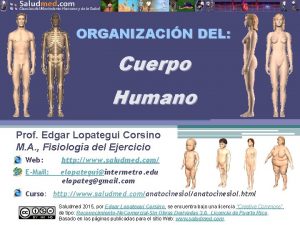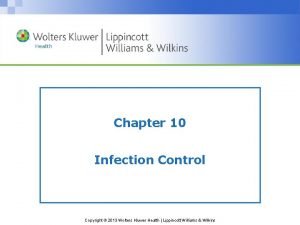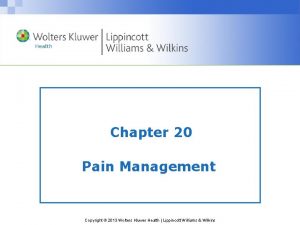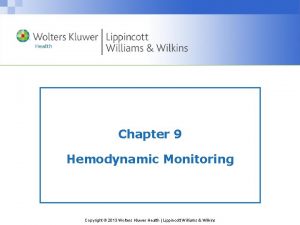Chapter 31 Health Supervision Copyright 2013 Wolters Kluwer



























- Slides: 27

Chapter 31 Health Supervision Copyright © 2013 Wolters Kluwer Health | Lippincott Williams & Wilkins

Principles of Health Supervision • Providing services proactively • Optimizing child’s level of functioning • Ensuring child is growing and developing appropriately • Promoting best possible health of child • Preventing injury and illness through child teaching Copyright © 2013 Wolters Kluwer Health | Lippincott Williams & Wilkins

Characteristics of a Medical Home Adapted from American Academy of Pediatrics, Medical Home Initiatives for Children With Special Needs Project Advisory Committee. (2008). The medical home. Retrieved April 17, 2011, from http: //aappolicy. aappublications. org/cgi/content/full/pediatrics; 110/1/184#T 1 Copyright © 2013 Wolters Kluwer Health | Lippincott Williams & Wilkins

Benefits of Health Partnerships With Child, Parents, and Community • Mutual goal setting • Marshalling of resources • Development of optimal health practices Copyright © 2013 Wolters Kluwer Health | Lippincott Williams & Wilkins

Special Issues in Health Supervision • Cultural influences • Community influences • Health supervision and the chronically ill child • Health supervision and the internationally adopted child Copyright © 2013 Wolters Kluwer Health | Lippincott Williams & Wilkins

Question Is the following statement true or false? The community can be a contributor to a child’s health or it can be the cause of his or her illnesses. Copyright © 2013 Wolters Kluwer Health | Lippincott Williams & Wilkins

Answer True. The community can be a contributor to a child’s health or it can be the cause of his or her illnesses. Rationale: The child is a member of a community as well as a family and a culture. The child’s health cannot be totally separated from the health of the surrounding community. Each community has unique strengths, weaknesses, and values that can affect a child’s health. Copyright © 2013 Wolters Kluwer Health | Lippincott Williams & Wilkins

Issues Covered in Psychosocial Assessments • Health insurance coverage • Transportation to health care facilities • Financial stressors • Family coping • School’s response to the chronic illness Copyright © 2013 Wolters Kluwer Health | Lippincott Williams & Wilkins

Three Components of Health Supervision • Developmental surveillance and screening • Injury and disease prevention • Health promotion Copyright © 2013 Wolters Kluwer Health | Lippincott Williams & Wilkins

Question Is the following statement true or false? The nurse providing pediatric health supervision should focus on the illness of children. Copyright © 2013 Wolters Kluwer Health | Lippincott Williams & Wilkins

Answer False. The nurse providing pediatric health supervision should focus on the wellness of children. Rationale: The health supervision visit provides an opportunity to maximize health promotion for the child, family, and community and nurses have the ability to promote optimal health during these encounters. Health supervision visits should be viewed as part of a continuum of care, not as the accomplishment of isolated tasks. Copyright © 2013 Wolters Kluwer Health | Lippincott Williams & Wilkins

Screenings Conducted at the Health Supervision Visit • History and physical assessment • Developmental/behavioral assessment • Sensory screening (vision and hearing) • Appropriate at-risk screening • Immunizations • Health promotion Copyright © 2013 Wolters Kluwer Health | Lippincott Williams & Wilkins

Components of Developmental Surveillance • Noting and addressing parental concerns • Obtaining a developmental history • Making accurate observations • Consulting with relevant professionals Copyright © 2013 Wolters Kluwer Health | Lippincott Williams & Wilkins

Question The nurse is conducting developmental surveillance on a child and his family. Which of the following is a component of this process? a. measuring the child’s head circumference b. administering vaccinations c. addressing parental concerns d. performing a physical assessment Copyright © 2013 Wolters Kluwer Health | Lippincott Williams & Wilkins

Answer c. addressing parental concerns is a component of developmental surveillance. Rationale: Developmental surveillance is an ongoing collection of skilled observations made over time during health care visits and includes noting and addressing parental concerns. Measuring the head circumference, administering vaccinations, and performing a physical assessment are components of the screenings conducted at the health supervision visit. Copyright © 2013 Wolters Kluwer Health | Lippincott Williams & Wilkins

Types of Screening • Risk assessment – Includes objective and subjective data to determine likelihood child will develop a condition • Universal screening – Screening of an entire population regardless of the child’s individual risk • Selective screening – Done when a risk assessment indicates the child has one or more risk factors for a disorder Copyright © 2013 Wolters Kluwer Health | Lippincott Williams & Wilkins

Specific Types of Screenings Performed • Metabolic • Hearing • Vision • Iron-deficiency anemia • Lead • Hypertension • Hyperlipidemia Copyright © 2013 Wolters Kluwer Health | Lippincott Williams & Wilkins

Hearing Risk Assessment for Children Ages 3 and 4 Copyright © 2013 Wolters Kluwer Health | Lippincott Williams & Wilkins

Criteria for Risk Assessment for Hearing Loss (Age 3 Month to 5 Years) • Auditory skill monitoring • Developmental surveillance • Assessment of parental concerns • Older than 4 years old • Difficulty hearing on the telephone • Difficulty hearing people in a noisy background • Frequent asking of others to repeat themselves • Turning the television up too loudly Copyright © 2013 Wolters Kluwer Health | Lippincott Williams & Wilkins

Using a Vision Screening Chart • Place the chart at the child’s eye level. • Place a mark on the floor 20 feet from the chart. • Align the child’s heels on the mark. • Have the child read each line with one eye covered and then with the other eye covered. • Have the child read each line with both eyes. Copyright © 2013 Wolters Kluwer Health | Lippincott Williams & Wilkins

Question The nurse is preparing a child for a vision screening. How far would the nurse place the child from the chart? a. 5 feet b. 10 feet c. 15 feet d. 20 feet Copyright © 2013 Wolters Kluwer Health | Lippincott Williams & Wilkins

Answer d. 20 feet. The nurse would place the child 20 feet from the vision screening chart. Rationale: When screening for vision, the nurse would place the chart at the child’s eye level, place a mark on the floor 20 feet from the chart, and align the child’s heels on the mark. Copyright © 2013 Wolters Kluwer Health | Lippincott Williams & Wilkins

Immunity • Immunity – Ability to destroy and remove a specific antigen from the body • Passive immunity – Produced when the immunoglobulins of one person are transferred to another • Active immunity – Acquired when a person’s own immune system generates the immune response Copyright © 2013 Wolters Kluwer Health | Lippincott Williams & Wilkins

Types of Vaccines • Live attenuated vaccines • Killed vaccines • Toxoid vaccines • Conjugate vaccines • Recombinant vaccines Copyright © 2013 Wolters Kluwer Health | Lippincott Williams & Wilkins

Vaccine Administration Routes Adapted from Immunization Action Coalition. (2009). Administering vaccines: Dose, route, site, and needle size. Retrieved April 17, 2011, from http: //www. immunize. org/catg. d/p 3085. pdf. We thank the Immunization Action Coalition. Copyright © 2013 Wolters Kluwer Health | Lippincott Williams & Wilkins

Types of Vaccines • Diphtheria, tetanus, and pertussis • Haemophilus influenzae type B • Polio, measles, mumps, and rubella • Hepatitis A and B • Varicella • Pneumococcal and influenza • Rotavirus • Human papillomavirus • Meningococcal Copyright © 2013 Wolters Kluwer Health | Lippincott Williams & Wilkins

Topics for Anticipatory Guidance • Promoting oral health care • Promoting healthy weight • Promoting healthy activity • Promoting personal hygiene • Promoting safe sun exposure Copyright © 2013 Wolters Kluwer Health | Lippincott Williams & Wilkins
 Wolters kluwer health
Wolters kluwer health Lippincott
Lippincott Wolters kluwer health
Wolters kluwer health Lippincott williams & wilkins
Lippincott williams & wilkins Wolters kluwer health
Wolters kluwer health Wolters kluwer health
Wolters kluwer health Wolters kluwer health
Wolters kluwer health Wolters kluwer health
Wolters kluwer health Wolters kluwer health lippincott williams & wilkins
Wolters kluwer health lippincott williams & wilkins Edgar lopategui corsino
Edgar lopategui corsino Wolters kluwer
Wolters kluwer Lippincott williams & wilkins
Lippincott williams & wilkins Exercise physiology for health, fitness, and performance
Exercise physiology for health, fitness, and performance Wolters kluwer
Wolters kluwer Wolters kluwer
Wolters kluwer Wolters kluwer
Wolters kluwer Wolters kluwer pronunciation
Wolters kluwer pronunciation Wolters kluwer
Wolters kluwer Copyright
Copyright Wolters kluwer
Wolters kluwer Wolters kluwer
Wolters kluwer Physical examination techniques
Physical examination techniques Wolters kluwer ovid
Wolters kluwer ovid Wolters kluwer culture
Wolters kluwer culture Wolters kluwer pronunciation
Wolters kluwer pronunciation Mbti personal impact report
Mbti personal impact report Kluwer
Kluwer Kluwer congres
Kluwer congres


















































